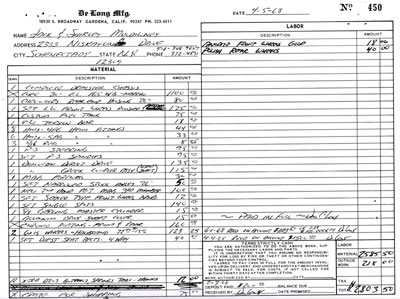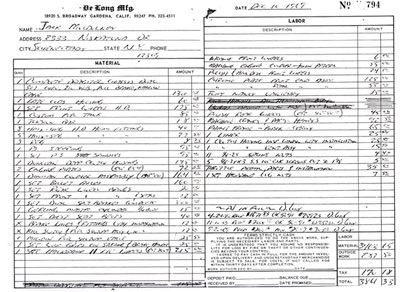

A little piece of her heart

Jack Muldowney bent the tubes and gas-welded together Shirley's first car, this gas dragster in which she earned her license.
|
Shirley Muldowney has had a lot of memorable firsts in her Hall of Fame career – first licensed female Top Fuel driver, first female Pro winner, first female world champion ... the list is too long to include here – but more than 40 years later, Muldowney remembered fondly for me another first in her career that meant the world to her: her first professionally built race car.
I got a nice little package in the mail last week from Shirley, filled with a time-capsule treasure trove of details about her first dragsters. She had actually received the car package from chassis builder Don Long, who had built her early iron, and it included not only original invoices but notes back and forth between the two parties asking for and confirming details and features on the cars.
Muldowney, of course, cut her racing teeth with street cars, and her Corvette was a regular winner at local tracks near the Schenectady, N.Y., home base for her and late husband Jack and son John. Shirley transitioned into a Chevy-powered B/Gas dragster that Jack built for her in 1964. The gas-welded mild steel digger, complete with a one-piece metal-flake fiberglass body that Jack had ordered, served her well, and it was in that car that she obtained her first dragster license, at Connecticut Dragway in 1965.
As their skill and desire increased, they outgrew the original homebuilt dragster and decided in late 1967 it was time to go all in and order a professionally built chassis. They scrimped and saved, and Jack, with John riding shotgun, picked up extra cash that winter plowing "an unbelievable number of driveways," recalled Shirley. "Because of Don Long's reputation for building the best cars that money could buy, we saved as much as we could, and we then put the call into Don's shop in Gardena, Calif."
The Muldowneys officially ordered their first car Jan. 31, 1968, in a letter written by Shirley to Long that included a $200 deposit check.

Muldowney's first "store-bought" car was this beautiful Don Long dragster.
|

The invoice. View larger
|
The price of the chassis was $1,100, which included all of the basic mounting hardware, firewall, clutch pedal, brake handle, butterfly steering wheel, pushbar, and more. The car was built from 4130 tubing and had a wheelbase of just 165 inches. The Muldowneys opted to add a narrowed 24-inch Chevy rear end ($80); lightweight 17-inch front wheels with polished aluminum billet hubs, aluminum rims, and chromed spokes ($175); PS lightweight steering and spindles ($190); custom fuel tank ($75); Donovan direct drive ($135) and "Greek" coupler ($115); five-way Deist 2-inch safety belts ($40); and other go-fast goodies.
The Muldowneys went first class in the looks department, too, spending $160 to chrome the front axle, radius rods, tie rod, spindles and spindle arms, torsion-bar arms, shock plates, drag links, steering idler, and pitman arm as well as the rear-end housing, steering wheel, and brake handle. The front wheels were gold anodized.
By the time that Long tallied up the final invoice April 5, the out-the-door price was $2,803.50, paid in two final checks of $1,500 and $1,103.50, the latter on June 1. Long crated up their new dragster for shipment ($75) for Newark, N.J., and insured it for $3,500.
"Jack, John, and I drove to Newark, and we were so excited that we just couldn't wait until the freight workers released the crate to us," Shirley remembered. "We were trying our best to view it through a small opening while using a flashlight. My first glimpse gave me goose bumps. We were on top of the world. We had a real Don Long race car, which was considered by every racer in our little part of the world as truly a masterpiece. We were now the best-equipped racers in the Northeast ... at least we thought we were. Even Ron Ronnie Abbott, who had a fuel car named Hellzapoppin' and was considered to be the top dog in the Tri-Cities (Albany/Schenectady/Troy, N.Y.), was so impressed that he vowed he would have one, too! Jack painted the car himself, red with gold-leaf lettering, and the finished car was, in fact, the nicest detailed car that Lebanon Valley had ever seen. Jack was also a master painter. I remember helping to do the masking job, along with whatever else he would let me do.
"Just about every racer at Lebanon Valley now hated me even more. They couldn't even imagine just how hard Jack had worked to buy me the car and the time and expense that had gone into fielding the car. It was no doubt a testament as to how early in my career I was able to enjoy driving the best that money could buy as far as race cars went. I can only thank Jack for that. For quite some time, it's been important for me to make sure as many fans know that I did in fact have some great race cars before I ever moved to Michigan. That's only fair to Jack. It's now time. And John was constantly at his dad's side when he worked to get the car ready to run, a good deal more than I was. I was working two jobs while Jack ran his Sinclair Service Station in the day and worked on the race car the minute he closed the overhead bay doors at 5 p.m."
John, who was just 10 years old, actually built the engine for that first car, which he says was a scaled-down version of the famed King & Marshall car. Already at a young age, John was showing signs of the skills that ultimately would make him a well-respected fabricator … not that there weren't setbacks.
"It was a 327 with a 350 crank, and I actually even ground the block to clear the rod bolts but ended up grinding through one of the water jackets," he admitted. "My dad made me braze it up to fix it. We got the blower and injector, a two-port Hilborn, from Ed Iskenderian, and, on its second pass, it equaled the national record."

Shirley suited up for a run in Indy in the twin-engined Double Trouble Top Gas dragster as Jack and John watched.
|
 |

The invoice: View larger
|
The second car, which was Muldowney's twin-engined gas dragster, Double Trouble, was ordered by the Muldowneys Sept. 16, 1969. The price of the 4130 chassis, described as "1 complete dragster chassis, dual 327 Chev, 210 WB, pull brake, narrow cage," was $1,300. The Muldowneys opted this time for a narrowed late Olds rear-end housing ($60) and upgraded to a DeLong braking assembly with Airheart dual calipers ($200).
On her behalf, on March 20, Long also commissioned tin impresario Ton Hanna to build the body for the car, specifying "one all-aluminum wrap-around body with nosepiece. Cowl to be 2" shorter than Adams, Ras [Rasmussen] & Scoggins car so brake handle clears and to facilitate driver entry & departure. Windshield to be squared like Ruth's. Cut hole in bellypan for vent." The whole package, out the door, was $3,861.33, according to the Dec. 10, 1969, invoice filled out by Long.
The Muldowneys again went first class, chroming a lot of the running gear and even splurging on wood grips for the steering wheel for $25. A $200 deposit got the work started, and they followed with a $2,000 payment in December and a final payment of $1,671.83 April 24.
Shirley and John hitched a new trailer to the back of her Buick Riviera street car and drove cross-country to California to pick up the car.
"It took me several days to pull up to Don's shop, but the trip was definitely a time to remember," she said. "Just the anticipation of seeing my dual-engine car for the first time was pretty exciting. Don and Jack had spent considerable time exchanging letters and on the phone, making sure all the measurements would be to my liking. The car was absolutely perfect the first time I sat in the seat. It was amazing how that all came together as nicely as it did. Don never wavered, questioned, or failed to give us exactly what we wanted. The very next day, together we took the car to Tony Nancy's upholstery shop for a rolled and pleated seat."
"With both of these dragsters, we only had one pulley change we could make; it was either 1:1 or 10 percent overdrive," recalled John. "We always ran the first car at 1:1, but I convinced my dad to go with 10 over for the dual-engine car, and it ran 198 mph at Indy, which was pretty good because we still weren't real savvy on clutches. Ed Pink was helping us out, and we got a lot of good advice, too, from John Peters, of Freight Train fame. He made the coupler for us and told us how to run the engines, advancing the front engine 90 degrees from the back to get rid of the harmonics that you'd get with two engines running the same. We did exactly what he said, and it worked good."
The dual-engined car eventually was sold to help buy their first Funny Car, and all of the Muldowneys wished they could have it back. John recalls seeing it 10 years later in the pages of National DRAGSTER and remembers that his dad, who died about two years ago, even briefly contemplated buying it back. "It still had the same paint and lettering, and he was so tempted to get it back but didn't, and he was so sorry later that he didn't. We haven't seen it since; it just vanished from the face of the earth," he said.
"If there was any car I wish I had today, it would be either one of those two cars," said Shirley. "If I had the chance to choose, I'd take the dual-engine car. It was without a doubt the slickest, nicest car I ever owned. I would give anything I own to have it today."



















































